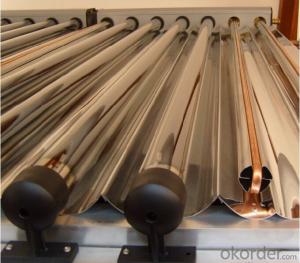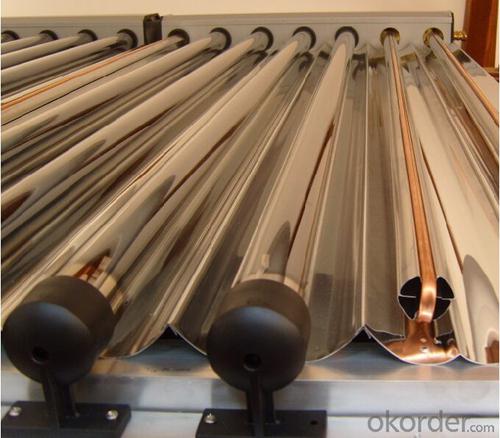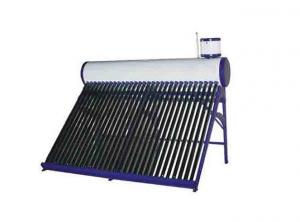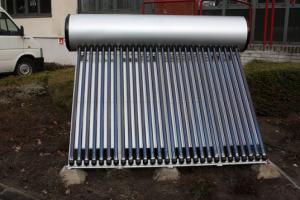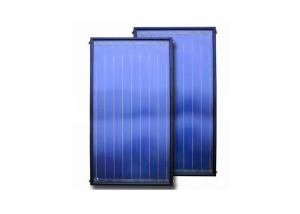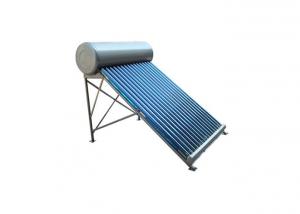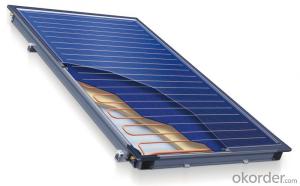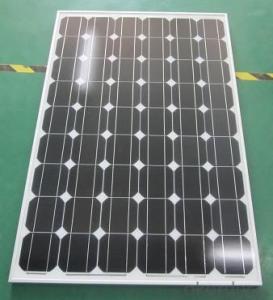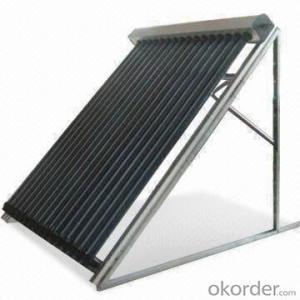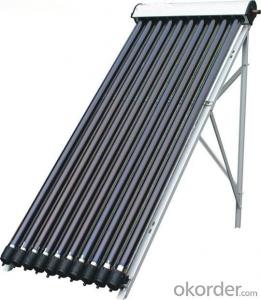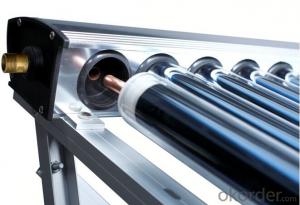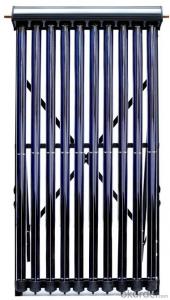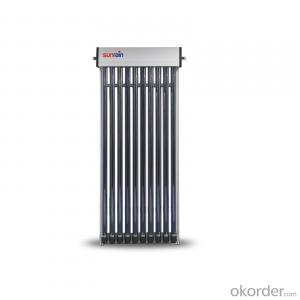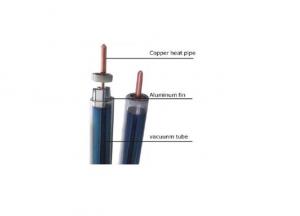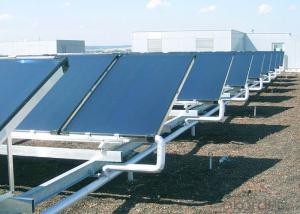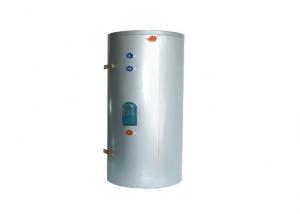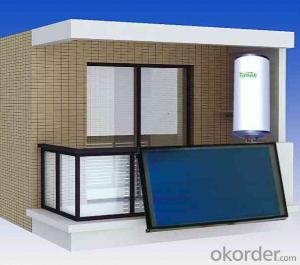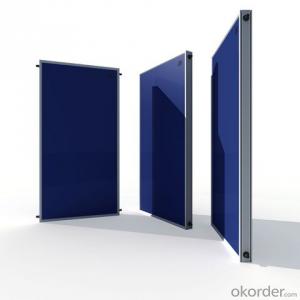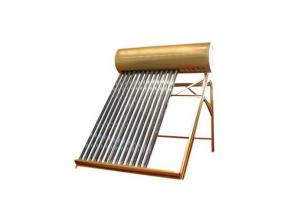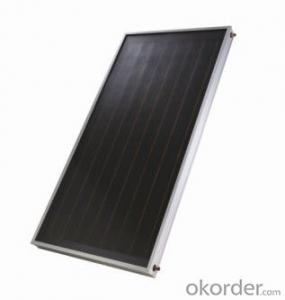Nanotek Solar Collectors SC-U Type Heat Pipe Model
- Loading Port:
- Shanghai
- Payment Terms:
- TT or LC
- Min Order Qty:
- 10 set
- Supply Capability:
- 1500 set/month
OKorder Service Pledge
OKorder Financial Service
You Might Also Like
1. Structure of Solar Collector with U Type Heat Pipe Model SC-U
Solar collector with U type heat pipe Model SC-U is composed of six parts:
(1) Solar Collector Mainfold
(2) Solar Collector Connection
(3) Solar Collector Frame
(4) Three Target Vacuum Tube
(5) Tube Support
(6) Windproof Feet
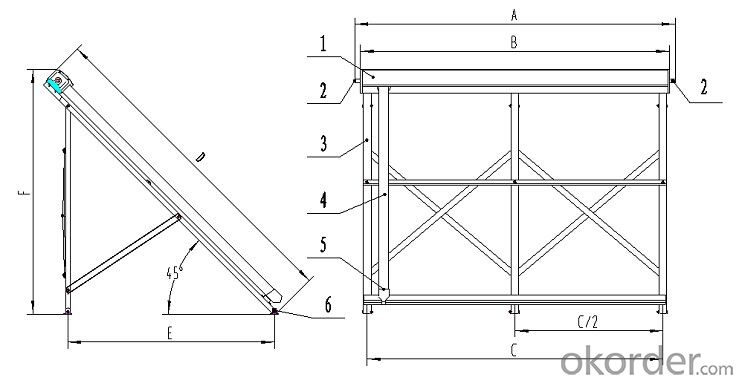
The products are approved by Europe's authoritative testing institutions, and achieve certification of Solar Keymark.
Also approved All types of solar collector,designed to meet customer needs,Modular structure,can install on the flat roof and sloped roof,easy to transport and install.
2. Main Features of Solar Collector with U Type Heat Pipe Model SC-U
All glass vacuum tube,High temperature resistance、Anti-freezing、Vacuum Insulation.
Superconducting copper heat pipe,high speed heat transfer,start as low temperature,low temperature resistance.
All aluminium alloy shell and frame,Surface oxidation or Spray preservative treatment,anti-corrosion,easy to install.
Keeping warm layer is high temperature resistance rock wool/glass wool, compression moulding forming,high density, low thermal conductivity.
Keeping Inner Tank makes from high pressure resistance,anti-corrosion,high-quality high-purity copper,can withstand 1Mpa.
Gravity heat pipe heat transfer unidirectionally,high collection efficiency,little heat loss.
3. Solar Collector with U Type Heat Pipe Model SC-U Images
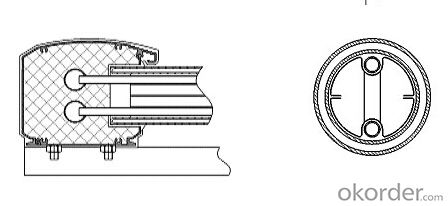
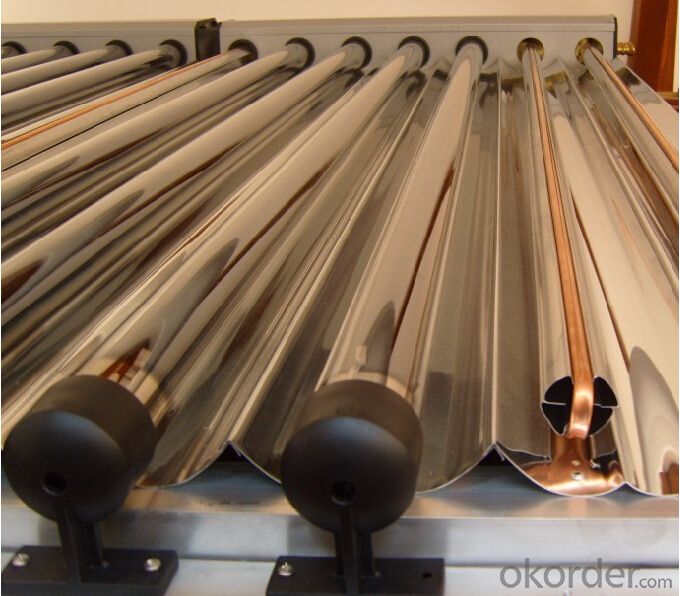
4. Solar Collector with U Type Heat Pipe Model SC-U Specification
MODEL | SC-U-15 | SC-U-18 | SC-U-20 |
Tubes Qty | 15 | 18 | 20 |
Distance between two tubes | 75 | 75 | 75 |
Diameter/Length of Vacuum tube(㎜) | φ58/1800 | φ58/1800 | φ58/1800 |
Material of vacuum tube | high borosilicate glass3.3 | high borosilicate glass3.3 | high borosilicate glass3.3 |
Thickness of inner/outer Vacuum tube(㎜) | 1.6/1.8 | 1.6/1.8 | 1.6/1.8 |
Diameter/Length of heat pipe condensor(㎜) | φ14/1750 | φ14/1750 | φ14/1750 |
U pipe material/thickness(㎜) | Cu tp2/0.5 | Cu tp2/0.5 | Cu tp2/0.5 |
Diameter/Thickness of inner tube(㎜) | φ22/1.0 | φ22/1.0 | φ22/1.0 |
Connection size | φ22( 3/4″) | φ22(3/4″) | φ22(3/4″) |
Keeping warm material/thickness(㎜) | Rock wool/40 | Rock wool/40 | Rock wool/40 |
Solar Collector Pressure(MPa) | 0.6 | 0.6 | 0.6 |
Solar Collector ℃working temperature | <100 | <100 | <100 |
Solar Collector Capacity(L) | 0.98 | 1.15 | 1.27 |
Solar Collector Aperture area(㎡) | 1.5 | 1.8 | 2.0 |
Solar Collector Total Area(㎡) | 2.30 | 2.74 | 3.04 |
Recommend flow(L/min) | 1.13 | 1.35 | 1.50 |
Pressure drop(Pa) | 59.2 | 90.6 | 116.7 |
Intercept effiency η0 | 0.78 | 0.78 | 0.78 |
Heat loss coefficient a | 2.09 | 2.09 | 2.09 |
Solar Collector Power(W)1000W/㎡ | 870 | 1047 | 1165 |
Solar Collector Net weight(kg) | 50.75 | 59.75 | 64.75 |
a (㎜) | 1270 | 1495 | 1645 |
b (㎜) | 1175 | 1400 | 1550 |
c (㎜) | 1100 | 1325 | 1475 |
c/2 (㎜) | —— | —— | —— |
d (㎜) | 1980 | 1980 | 1980 |
e (㎜) | 1240 | 1240 | 1240 |
f (㎜) | 1470 | 1470 | 1470 |
5. FAQ
What happens if one of the solar tubes is broken?
Firstly, tubes are very strong and not easily broken, but if the worst should happen, solar tubes can be replaced very easily. They are inexpensive and available. The solar collectors can operate with several broken tubes, but the efficiency will be reduced, so it is recommended that broken tubes be replaced immediately.
Can the solar collectors be mounted on a flat surface?
Yes they may be mounted on a flat roof or on the ground by using a stainless steel Flat Roof Frame. The collector should be installed at a minimum of 20o angle to ensure optimal operation of the heat pipe.
Will the solar collector be a fire hazard during hot, dry weather?
No. The solar collector's components are all high temperature rated and non-flammable, so even during strong sunlight with the circulation pump turned off (stagnation), the system will not catch alight or give off any sparks. The majority of the solar collector's components are stainless steel, aluminium, glass or glass wool. The manifold outlet should be fitted with a temperature relief valve, which will prevent the manifold temperature from exceeding 99oC / 212oF.
- Q: Can solar collectors be used in solar thermal biomass gasification?
- Yes, solar collectors can be used in solar thermal biomass gasification. Solar collectors can provide the necessary heat for the gasification process, which involves converting biomass into a gaseous fuel. By harnessing solar energy, the collectors can supplement or replace traditional heating methods, making the gasification process more sustainable and environmentally friendly.
- Q: Can solar collectors be used in areas with limited access to educational resources?
- Yes, solar collectors can be used in areas with limited access to educational resources. Solar collectors are relatively simple and do not require extensive technical knowledge to operate. With basic training and guidance, individuals in these areas can learn to install, maintain, and utilize solar collectors for their energy needs. Additionally, solar energy can significantly reduce dependence on traditional energy sources, making it a viable option in regions with limited access to educational resources.
- Q: Can solar collectors be used in water treatment plants?
- Yes, solar collectors can be used in water treatment plants. They can be utilized to provide renewable energy for various processes such as powering pumps, filters, and disinfection systems. Solar thermal collectors can also be used to heat water for sterilization and other treatment methods. These applications help reduce reliance on fossil fuels and contribute to a more sustainable and environmentally friendly water treatment process.
- Q: Can solar collectors be used in areas with limited access to maintenance services?
- Yes, solar collectors can be used in areas with limited access to maintenance services. Solar collectors are known for their low maintenance requirements due to their simple design and reliable technology. They have few moving parts and are built to withstand various environmental conditions. Additionally, regular maintenance tasks such as cleaning the panels can be performed by locals without specialized knowledge or equipment. Therefore, solar collectors can be a suitable and sustainable energy solution in remote areas with limited access to maintenance services.
- Q: Can solar collectors be used for heating botanical gardens?
- Yes, solar collectors can be used for heating botanical gardens. Solar collectors can harness the sun's energy to provide heat for various purposes, including heating greenhouse structures in botanical gardens. This sustainable and cost-effective solution can help maintain optimal temperature conditions for plants and create a conducive environment for their growth.
- Q: Can solar collectors be used in areas with limited access to certification bodies?
- Yes, solar collectors can be used in areas with limited access to certification bodies. While certification is important to ensure the quality and safety standards of solar collectors, it is not always mandatory. In such cases, it becomes the responsibility of the user or installer to ensure that the solar collectors meet the necessary requirements and standards. They can do so by conducting thorough research on reputable manufacturers, checking for customer reviews and testimonials, and consulting with experts or professionals in the field. Additionally, in areas with limited access to certification bodies, local regulations and guidelines may provide alternative ways to ensure the reliability and performance of solar collectors.
- Q: Can solar collectors be used for heating green roofs?
- Yes, solar collectors can be used for heating green roofs. Solar collectors can capture and convert sunlight into heat energy, which can then be used to warm the green roof's soil or irrigation system. This can help to extend the growing season, increase plant productivity, and promote overall health of the green roof ecosystem.
- Q: What maintenance is required for solar collectors?
- Solar collectors require regular maintenance to ensure optimal performance and longevity. Some of the key maintenance tasks include cleaning the collectors periodically to remove dust, debris, and any other obstructions that may hinder sunlight absorption. Additionally, the plumbing system and valves should be inspected for leaks or damages. It is also important to monitor the fluid levels and quality in the system, and make necessary adjustments or replacements as required. Regular inspections and maintenance by professionals can help identify and address any potential issues before they escalate, ensuring the efficient operation of solar collectors.
- Q: How are solar collectors different from solar panels?
- Solar collectors and solar panels are both used to harness the energy from the sun, but they differ in their purpose and functionality. Solar collectors are specifically designed to capture and convert thermal energy from the sun into heat. These collectors are typically used for heating water or air in residential, commercial, or industrial applications. They consist of a series of tubes or pipes that circulate a heat transfer fluid, such as water or antifreeze, which absorbs the heat from the sun and transfers it to a storage tank or directly to the desired application. Solar collectors are most commonly used in solar water heating systems or for space heating. On the other hand, solar panels, also known as photovoltaic (PV) panels, are used to convert sunlight directly into electricity. They consist of multiple solar cells made of semiconductor materials, such as silicon, which generate electricity when exposed to sunlight. Solar panels are primarily used for generating electricity in residential, commercial, and utility-scale solar power systems. They can be mounted on rooftops, integrated into building materials, or installed as ground-mounted arrays. In summary, solar collectors are designed to capture and convert solar energy into heat, while solar panels are used to directly convert sunlight into electricity. Both technologies play important roles in harnessing solar energy and are utilized in various applications to reduce dependence on traditional sources of energy and promote sustainability.
- Q: Can solar collectors be used for heating theaters and concert halls?
- Yes, solar collectors can be used for heating theaters and concert halls. Solar thermal systems can be installed to collect and convert sunlight into heat energy, which can then be used for space heating in large venues such as theaters and concert halls. This sustainable solution reduces the reliance on traditional heating methods and promotes energy efficiency.
Send your message to us
Nanotek Solar Collectors SC-U Type Heat Pipe Model
- Loading Port:
- Shanghai
- Payment Terms:
- TT or LC
- Min Order Qty:
- 10 set
- Supply Capability:
- 1500 set/month
OKorder Service Pledge
OKorder Financial Service
Similar products
Hot products
Hot Searches
